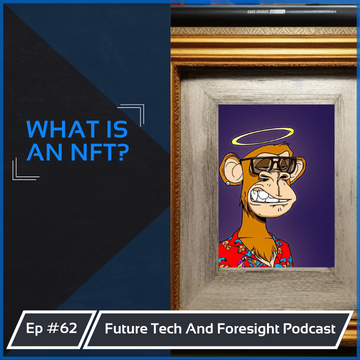About The Episode
Over the last few months you may have read an article or a social media post about a well known person like Grimes, Jack Dorsey, John Cleese, Mark Cuban, Paris Hilton and many others join the NFT frenzy.
They have been offering videos, signed tweets, drawings, and even releasing an NFT art gallery, bringing dollars and more importantly attention to this technology as NFTs enter mainstream awareness. So today we will be looking at what these NFTs are, and what are the possible ramifications are in the future.
Transcript
I typically like to jump right into the episodes and mostly avoid any preamble, as this has also been the feedback that I’ve been given from many of you listening. But today’s episode topic was requested by a listener so I just wanted to mention that if there is an interesting technology you are aware and think it would have a significant impact on society or jobs please let me know and I’d be happy to dedicate a podcast to it, either as a solo monologue or with a relevant guest. But even without a direct request I will still continue to cover the occasional big news items that are relevant for the themes of the podcast.
Over the last few months you may have read an article or a social media post about a well known person like Grimes, Jack Dorsey, John Cleese, Mark Cuban, Paris Hilton and many others join the NFT frenzy. They have been offering videos, signed tweets, drawings, and even releasing an NFT art gallery, bringing dollars and more importantly attention to this technology as NFTs enter mainstream awareness.
So what exactly are NFTs?
Firstly, non-fungible simply means something is unique and cannot be traded or replaced equally for something else. This means that the object is ensured to be unchanged and secured forever. This can be a single unique item, or multiple unique items which belong to a set. The best and perhaps most relevant example are trading sports cards. They are Non-fungible, you can decide to trade one player for another but you clearly own something different once that trade has happened.
This is not the case say, for a one dollar bill, where both people doing the trade end up with arguably the exact same thing. I say arguably because one might have a small rip, or a stain. But when that dollar is digital, that traded dollar is completely fungible.
This leads us to the second part of NFTs or the ‘token’ aspect. NFTs predominately exist on the Ethereum blockchain. The second largest cryptocurrency which apart from supporting the native Ethereum token, also supports other tokens on which additional information can be stored. NFTs are not limited to Ethereum however, other blockchains already host NFTs. The reason that Blockchain is being used as the host or platform for NFTs is due to the tracking nature of blockchains. Digital data (like transactions) on a blockchain is stored and kept as a permanent record available for all to see and verify, which lends itself perfectly to securing unique and secured digital information like NFTs.
In short, an NFT is an untampered and tamperproof certificate of authenticity and ownership.
Some Examples of NFTs
Currently, the main field of application of such tokens is the gaming industry where gamers purchase unique weapons and other digital assets to improve the gaming experience. But with the growing interest in this technology the uses are growing.
According to NonFungible.com, NFTs are distributed as follows:
41% – the gaming industry;
29% – collectibles;
13% – real estate;
7% – collectible card games;
6% – domain names;
4% – art.
So even though art makes up a very small percentage of the total NFT market, there is significant public interest in this asset class. This might also have something to do with the price tag attached to some of them. The art for the episode is ‘Dragon’, the most expensive NFT cryptokitty that was part of a popular NFT Pokemon like game that actually nearly shut down the Ethereum Blockchain in late 2017. Dragon sold for 600 Ethereum tokens, worth roughly 1.3Million USD today. However this pales in comparison to the latest NFT craze where we are seeing multi-million dollar sales for individual NFTs. Jack Dorsey’s first tweet alone went for over 1600ETH or about 3 million USD. But apart from the monetary craze that this digital asset class is creating what is the real value that NFTs hold?
What value do they have
The first thing that came to my mind when I heard about these back in early 2018, might be the same thing that you are thinking about…the creation of scarce digital goods. Though a relatively simple idea, it might actually sound at first to be a bit of an oxymoron. When you picture digital goods usually the most common characteristics are abundant and replicable. Think of an e-book as a very typical digital good compared to a real paperback book, and though the words are the exact same in each case, the digital copy can of course can be copied and shared an unlimited number of times with practically zero marginal cost for each additional e-book. This has actually been one of the underlying tenets that has allowed for massive growth in digital business over the last 20 years.
But as interactions and transactions have become dominated by this digital medium it has also put stress on traditional forms of work and businesses. It is much easier, and costs much less to setup an online store with dropshipping compared to a brick and mortar one. The same can be said for almost all aspects of our civilisation as digitalisation becomes more ubiquitous with each passing year, (irrespective of the forced push due to Covid). Therefore, the growing expectation of digital transactions stresses traditional or classic work. It is perhaps no surprise then that art has become the centre of attention for NFTs. As platforms like Instagram have also pushed artists further and further towards digital collaboration, marketing, and selling the notion of art ownership has been diluted somewhat.
NFTs offer a possible solution. By creating a unique and scarce digital piece of art the unlimited replication of art pieces is reversed, bringing back traditional ownership models in our new digital environment.
But the possible benefit isn’t without controversy. Bit rot, where image quality deteriorates with time, the contribution towards global warming by simply using blockchains, or whether the ownership of an NFT is fundamentally worth anything, all swirl around the discussion of NFTs. But what has me more interested is their possible future impact.
What is the possible future impact of NFTs on jobs and us?
As already mentioned, currently the focus of NFTs is on high profile artwork and collectibles like Jack Dorsey’s tweet. This is expected as both understanding of what NFTs actually are and what their uses are are explored. But apart from being able to support artists, a powerful utility can be seen in real estate.
Like many traditional markets, transferring property ownership is both time consuming and labour intensive, not to mention expensive. Real estate also lends itself perfectly to NFTs. It is stationary, non-fungible, and easily verified by independent parties. Not to mention in most parts of the world, real-estate is already highly identified, detailed, and registered. Therefore by tokenizing the property rights, the labour intensive transfer becomes significantly easier, faster, and less expensive. We could see an entire industry collapse practically overnight if this were to take place. The intermediary would dissolve, enabling both buyer and seller to interact in a more direct yet trusting interaction, which by the way, is one of the main arguments for blockchain as a whole.
As a side note, if this were to happen this then also frees up a further opportunity for borrowing against your house or apartment with relative ease, or even divide the real-estate up to be sold in a time-share model. There are several opportunities on the table here, and the second order effects are numerous, but as this is already fitting in the speculative area it’s best to just note this possibility for now.
Real estate is however a relatively easy asset class where this shift can happen, but it isn’t impossible to see this occurring for other goods like vehicles, IP rights, licensing, insurance, appraisals, and some have some have even predicted far out ideas like representing living things like endangered species or perhaps even humans!
But this is beyond what we can know for sure right now. As the new NFT market continues to grow and gain interest I’m sure we will see other applications quickly be onboarded in the years ahead. This is especially true as we continue to see a blurring of the digital and real worlds. Who knows, perhaps in the next few years even this podcast or specific episodes could be bought as exclusive NFTs.











